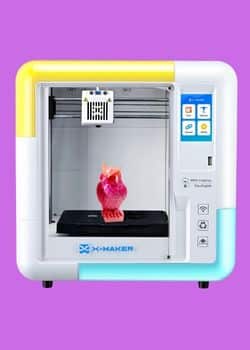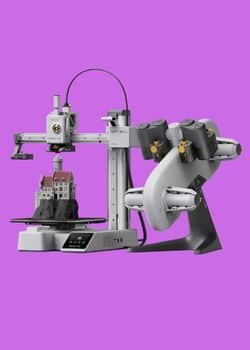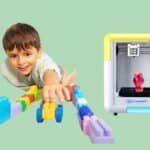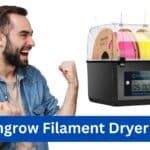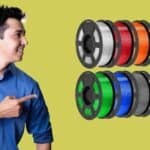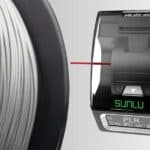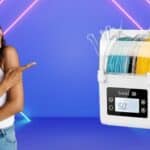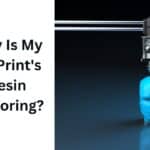
Safe 3D printers like AOSEED X-Maker, Asani Mini, and Bambu A1 Mini, with enclosed designs and PLA filaments, spark creativity in autistic kids. Start with sensory-friendly projects like fidget spinners for fun, engaging learning in 2025.
Your autistic child’s face lights up with pride, holding a custom fidget toy they designed and 3D-printed. For kids on the autism spectrum, 3D printing offers more than fun—it’s a powerful tool for sensory engagement, skill-building, and self-expression. The hands-on process captivates their senses, while creating tangible objects boosts confidence. Safety remains paramount, and in 2025, top 3D printers for autistic kids feature enclosed designs, non-toxic PLA filaments, and intuitive interfaces for worry-free creativity.
Affiliate Disclosure
We participate in Amazon affiliate programs, earning fees from qualifying purchases via links at no extra cost to you. It’s how we keep this blog rolling and my 3D printers buzzing with fresh filament for reviews like this one!
This guide dives into the best kid-friendly 3D printers, key safety features, and exciting projects to ignite your child’s imagination. Let’s explore the top picks for 2025!
Why 3D Printing Benefits Autistic Kids
3D printing offers unique therapeutic and educational benefits for autistic children, making it an ideal activity for home, school, or therapy settings:
- Sensory Engagement: The tactile and visual process of designing and printing soothes sensory-seeking kids, reducing anxiety.
- Fine Motor Skills: Handling filaments and printed models improves dexterity and hand-eye coordination.
- Focus and Patience: Watching a print take shape over time encourages sustained attention, a challenge for many autistic kids.
- Creativity and Confidence: Designing custom toys or fidgets boosts self-esteem and a sense of accomplishment.
Research from STEM educators, like those at FunTech, shows that hands-on activities like 3D printing for autism enhance cognitive and emotional growth. With safe, user-friendly printers, kids as young as 6 can explore this technology under supervision.
Key Features to Look for in Safe 3D Printers
When selecting a 3D printer for autistic kids, focus on safety, simplicity, and sensory-friendly features:
- Enclosed Design: Shields hot nozzles (200–280°C) to prevent burns and contains fumes.
- Non-Toxic PLA Filament: Low-temperature, biodegradable, and fume-free, ideal for kids.
- Auto-Leveling: Simplifies setup, reducing frustration for beginners.
- Kid-Friendly Interface: Apps or one-touch controls make operation accessible for young users.
- Quiet Operation: Noise levels under 50 dB suit sensory-sensitive kids.
- Community Resources: Access to model libraries (e.g., MakerWorld) encourages exploration.
These features ensure a kid-friendly 3D printer is safe, engaging, and supportive of autistic children’s needs, allowing them to focus on creativity without overwhelming complexity.
Top 5 Safe 3D Printers for Autistic Kids in 2025
Below are the best 3D printers for autistic kids in 2025, chosen for their safety, ease of use, and ability to spark creativity. Each includes detailed features, pros, cons, and an affiliate link for easy purchasing.
1. AOSEED X-Maker ($399.99)
The AOSEED X-Maker is a standout choice for autistic kids, designed specifically for children and beginners. With a 4.2-star rating on Amazon, it combines a fully enclosed, microwave-like design with a gamified app featuring 15+ mini-apps to make 3D printing fun and educational. Its high-spec hardware delivers reliable performance, exceeding typical “toy-level” printers. The transparent window with LED lights lets kids safely observe the printing process, engaging visual senses without exposing them to hazards. Ideal for kids 8+, this printer supports independent operation with minimal setup, making it perfect for home or classroom use. Users like Erica Carter praise its “plug & go” simplicity, though some report customer service issues.
Key Features
- Fully enclosed design with transparent observation window and LED lights.
- Wi-Fi-enabled app with 15+ gamified mini-apps for design and printing.
- Auto-leveling for hassle-free setup.
- Supports PLA filament (non-toxic, biodegradable).
- Ultra-quiet operation (<50 dB) for sensory-sensitive kids.
- 160 mm/s printing speed for quick results.
- Voice control and toy customizer via app.
- 5-minute installation with USB, Wi-Fi, and internal storage connectivity.
Pros
- ✅ Enclosed design maximizes safety by preventing access to hot parts.
- ✅ Kid-friendly app with voice control and gamified features engages autistic kids.
- ✅ Quiet operation suits sensory sensitivities.
- ✅ Fast setup and auto-leveling reduce frustration for beginners.
Cons
- ❌ Customer service can be inconsistent; buy from reputable sellers.
- ❌ Medium print volume (5.9” cube) limits larger projects.
- ❌ Wi-Fi dependency may be an issue in low-connectivity areas.
2. Asani Mini 3D Printer ($249.99)
The Asani Mini 3D Printer is a compact, budget-friendly option with a 4.5-star rating, perfect for autistic kids in small spaces like classrooms or bedrooms. Learn more about its features in our Asani Mini 3D Printer Review: Affordable, User-Friendly, and Kid-Approved. Weighing just 6.4 lbs, it’s portable and easy to store, with a 2.4” LCD touchscreen for intuitive control. Its one-touch filament loading and Wi-Fi connectivity simplify operation, while the enclosed design ensures safety. This printer supports both PLA and flexible TPU filaments, offering versatility for sensory-friendly projects like squishy toys. Best for kids 6+, it’s an excellent entry-level choice, as Katie K notes for its family-friendly setup. Its small print volume, however, limits larger creations.
Key Features
- Fully assembled with enclosed design for safety.
- Auto-leveling for easy bed calibration.
- One-touch filament loading system.
- Wi-Fi connectivity and 2.4” LCD touchscreen.
- Supports PLA and TPU filaments.
- 200 mm/s printing speed for efficient prints.
- Quiet operation for sensory-friendly environments.
- Compact size (3.9” x 3.9” x 4.7” print volume).
Pros
- ✅ Lightweight and portable, ideal for small spaces.
- ✅ One-touch controls and touchscreen simplify use for young kids.
- ✅ Supports TPU for sensory-friendly, flexible prints.
- ✅ Affordable price point for budget-conscious families.
Cons
- ❌ Small print volume restricts project size.
- ❌ Limited filament options compared to advanced models.
- ❌ Enclosed design may still require supervision for very young kids.
3. Entina Tina2S ($229.99)
The Entina Tina2S is a beginner-friendly printer with a 4.3-star rating, praised for its affordability and robust Wi-Fi app. Check out its full review in our Entina Mini Tina 2 3D Printer Review: The Perfect Starter Printer. Its open-source design allows access to a vast model library, perfect for autistic kids who enjoy exploring new designs. The heated spring steel plate ensures easy print removal, reducing frustration, while auto-leveling simplifies setup. Though it lacks a full enclosure, its compact size and ultra-quiet operation make it suitable for kids 7+ in supervised settings, such as classrooms or therapy rooms. Users appreciate its seamless app integration, though connectivity can occasionally falter.
Key Features
- Fully assembled with auto-leveling.
- Heated spring steel plate for easy print removal.
- Wi-Fi app with access to open-source model libraries.
- Supports PLA filament.
- Ultra-quiet operation (<50 dB).
- 200 mm/s printing speed.
- Compact print volume (3.9” x 3.9” x 4.7”).
- SD card and USB connectivity for offline printing.
Pros
- ✅ Affordable and open-source, with access to extensive model libraries.
- ✅ Easy print removal reduces frustration for kids.
- ✅ Quiet operation ideal for sensory-sensitive environments.
- ✅ Fast printing speed keeps kids engaged.
Cons
- ❌ Open design requires closer supervision for safety.
- ❌ Small print volume limits project scope.
- ❌ App may have occasional connectivity issues.
4. Creality Ender 3 ($179.00)
The Creality Ender 3 is a budget-friendly, open-frame printer with a 4.2-star rating, best for tech-savvy autistic kids 10+ who enjoy hands-on learning. Its large print volume supports bigger projects, and its open-source nature allows customization and access to community resources like Printables.com. Assembly (2–4 hours) teaches mechanics, but the lack of an enclosure and manual leveling make it less suitable for younger kids. With supervision, it’s a fantastic educational tool, as Darren notes for its surprising print quality. Its noise level, however, may challenge sensory-sensitive kids.
Key Features
- Open-frame design with large print volume (8.66” x 8.66” x 9.84”).
- Resume printing function for power outages.
- Open-source with SD card and USB connectivity.
- Supports PLA filament (optional ABS with upgrades).
- Manual bed leveling.
- Stable metal frame for durability.
- Community-driven model libraries and tutorials.
- 100 mm/s printing speed (upgradable).
Pros
- ✅ Lowest price point for a large print volume.
- ✅ Educational assembly process fosters STEM skills.
- ✅ Open-source design supports customization and learning.
- ✅ Durable frame ensures long-term use.
Cons
- ❌ Open-frame design poses burn risks, requiring close supervision.
- ❌ Assembly and manual leveling are time-consuming and complex.
- ❌ Noisier operation (~55 dB) may overwhelm sensory-sensitive kids.
5. Bambu Lab A1 Mini Combo ($679.00)
The Bambu Lab A1 Mini Combo is a premium, 4.4-star-rated printer with multi-color printing via the AMS Lite system, perfect for autistic kids who love vibrant, sensory-rich creations. Compare it with other models in our Bambu Lab A1 Mini vs. Flashforge Adventurer 5M. Its auto-calibration and Wi-Fi app (Bambu Handy) simplify operation, while the MakerWorld platform offers thousands of pre-sliced models. With a quiet (<48 dB) and compact design, it’s ideal for kids 9+ in supervised settings. The higher price and AMS complexity make it best for families committed to advanced 3D printing, as Craig M. praises for its “plug and play” ease.
Key Features
- Full-auto calibration (bed leveling, vibration, flow).
- AMS Lite for 4-color printing.
- Wi-Fi app (Bambu Handy) and MakerWorld model library.
- Supports PLA, PETG, and TPU filaments.
- Ultra-quiet operation (<48 dB).
- 10,000 mm/s² acceleration for fast prints.
- Medium print volume (7.1” cube).
- Built-in camera for remote monitoring.
Pros
- ✅ Multi-color printing engages sensory-seeking kids.
- ✅ Auto-calibration and app make setup effortless.
- ✅ Quiet and compact, ideal for home use.
- ✅ High-quality prints with minimal waste (purge wiper).
Cons
- ❌ High price point limits accessibility.
- ❌ AMS Lite adds setup complexity for younger kids.
- ❌ Color printing generates some filament waste.
Comparison Table: Best 3D Printers for Autistic Kids
| Brand | Price | Safety Features | Ease of Use | Print Volume | Best For |
|---|---|---|---|---|---|
| AOSEED X-Maker | $399.99 | Enclosed, PLA-only, quiet | App-based, one-key printing | Medium (5.9” cube) | Kids 8+, sensory play |
| Asani Mini | $249.99 | Auto-leveling, PLA/TPU | One-touch loading, LCD | Small (3.9” x 3.9” x 4.7”) | Kids 6+, classrooms |
| Entina Tina2S | $229.99 | Auto-leveling, quiet | App, open-source | Small (3.9” x 3.9” x 4.7”) | Kids 7+, beginners |
| Creality Ender 3 | $179.00 | Resume printing, PLA | Manual setup, SD card | Large (8.66” x 8.66” x 9.84”) | Kids 10+, tech-savvy |
| Bambu A1 Mini | $679.00 | Auto-calibration, quiet | App, multi-color | Medium (7.1” cube) | Kids 9+, colorful prints |
Rating Table: How These Printers Stack Up
| Brand | Safety | Ease of Use | Educational Value | Overall |
|---|---|---|---|---|
| AOSEED X-Maker | 4.5 ★★★★★ | 4.5 ★★★★★ | 4.0 ★★★★ | 4.2 ★★★★ |
| Asani Mini | 4.0 ★★★★ | 4.5 ★★★★★ | 4.0 ★★★★ | 4.3 ★★★★ |
| Entina Tina2S | 3.5 ★★★ | 4.5 ★★★★★ | 4.0 ★★★★ | 4.0 ★★★★ |
| Creality Ender 3 | 3.0 ★★★ | 3.5 ★★★ | 4.5 ★★★★★ | 3.8 ★★★★ |
| Bambu A1 Mini | 4.5 ★★★★★ | 4.0 ★★★★ | 4.5 ★★★★★ | 4.4 ★★★★ |
Fun 3D Printing Projects for Autistic Kids
Spark your child’s creativity with these sensory-friendly, autism-appropriate projects:
- Fidget Spinners: Smooth, spinning toys reduce anxiety. Free models on Printables.com.
- Sensory Blocks: Textured, stackable blocks for tactile exploration.
- Custom Keychains: Personalized with names or shapes, boosting pride.
- Tactile Puzzles: Simple 3D puzzles enhance problem-solving.
Use vibrant silk PLA filaments like SUNLU or ERYONE for glossy, eye-catching results. These quick-to-print projects are safe and engaging, perfect for 3D printing for special needs.
Safety and Setup Tips for Parents
Ensure a safe 3D printing experience with these practical tips from our guide on 3D Printing Safety Gear Must-Haves for Resin and FDM Decor Projects:
- Use PLA Filament: Non-toxic and low-temperature, it’s the safest choice for kids.
- Supervise Printing: Monitor younger kids, even with enclosed printers, to avoid hot parts.
- Ventilate the Area: Open windows or use a fan to disperse minor fumes.
- Teach Hygiene: Encourage hand-washing after handling prints to avoid residue.
- Use a Webcam: Monitor prints remotely for added safety.
Opt for enclosed models like the AOSEED X-Maker or Bambu A1 Mini for maximum safety, especially for sensory-sensitive kids.
FAQs About 3D Printing for Autistic Kids
Are 3D printers safe for autistic kids?
Yes, with enclosed designs, PLA filament, and supervision, printers like the AOSEED X-Maker are safe for kids 6+.
What age is best to start 3D printing?
Kids 6+ can start with user-friendly models under supervision; older kids (10+) can handle models like the Ender 3.
Which filament is safest?
PLA is non-toxic, low-temperature, and biodegradable, making it ideal for kids.
Can 3D printing help with sensory issues?
Yes! The tactile and visual process engages sensory-seeking kids, reducing stress and promoting focus.
Conclusion
3D printing unlocks a world of creativity, focus, and skill-building for autistic kids, making it a rewarding activity for home or school. In 2025, safe 3D printers for autistic kids like the AOSEED X-Maker, Asani Mini, and Bambu A1 Mini offer enclosed designs, PLA filaments, and kid-friendly apps to ensure safety and fun. Start with a sensory-friendly project like a fidget spinner and watch your child’s confidence soar. Dive into 3D printing today and empower your child to create!

